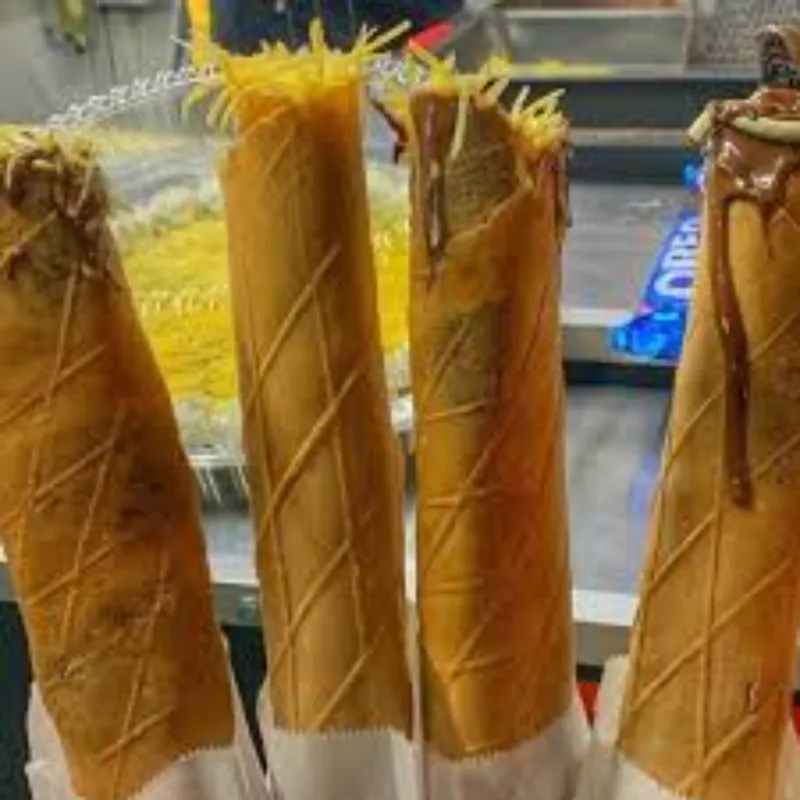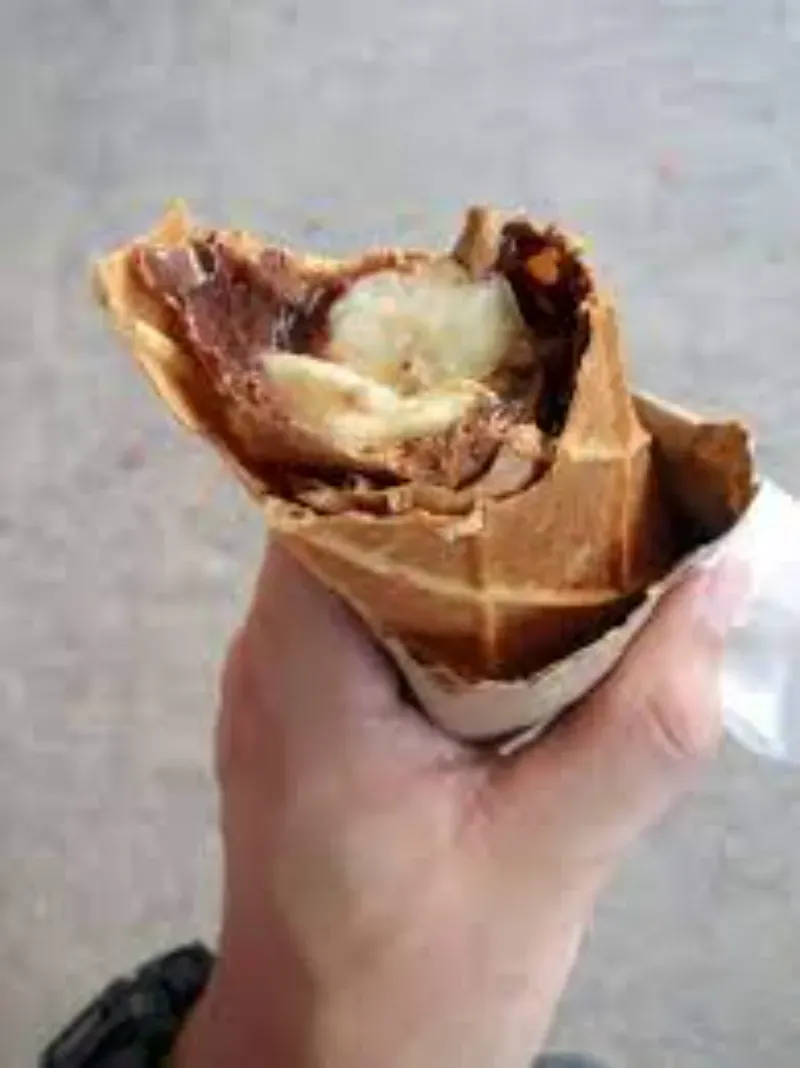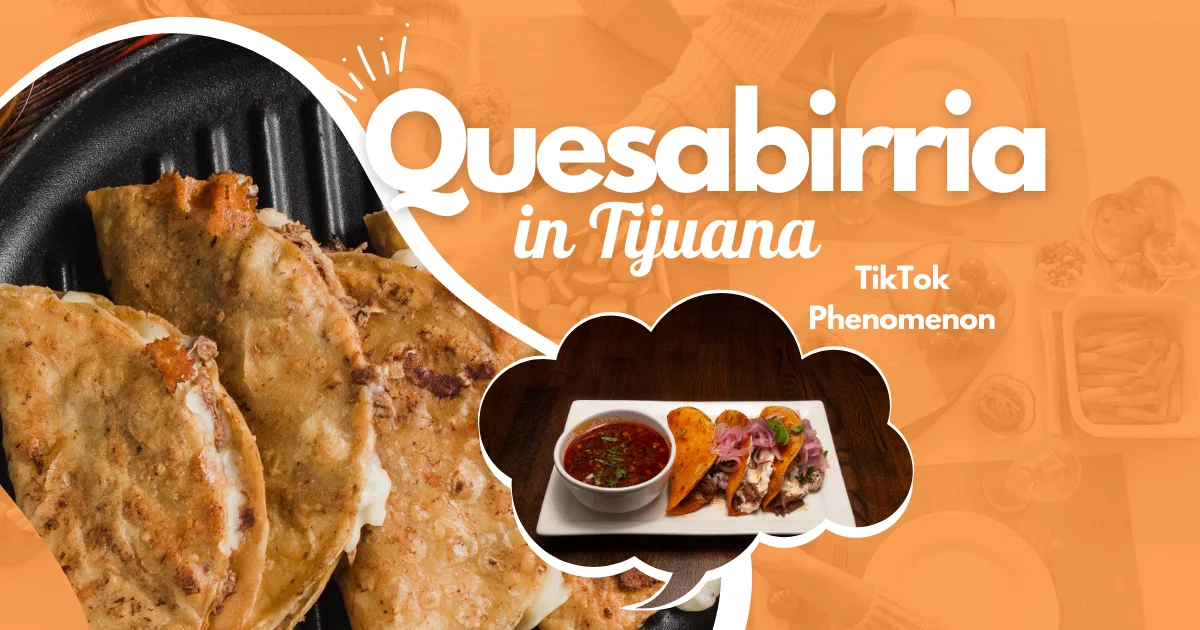Marquesitas are crunchy, folded crepes from Yucatán that have become a must-try street dish. They are part candy, part pancake, and all about texture and appeal. They have a hard shell, warm contents, and a last shave of salty cheese. This page discusses what Marquesitas are, their origin, pricing, and composition. It also discusses how social media converted a Mérida specialty into a worldwide crepe-tube candy craze.
Contents
What Is a Marquesita?
A Marquesita begins with a thin batter that resembles a pancake. The batter is poured onto a hot round griddle and stretched out into a wide, thin disc. The vendor cooks the batter until the edges get golden and the surface dries out. Then, they put a ribbon of filling around the outside. The vendor rolls the disc into a tight tube while it is still soft, sealing in the contents. The last step is to grate a large amount of queso de bola, which is also known as Edam cheese worldwide. This cheese softens a little on the warm crust and adds a savory flavor.

When you eat a Marquesita, you get three different tastes at once: the crunchy shell, the warm, gooey filling, and the surprising savory finish from the cheese. Marquesitas are great for market walks and late-night food walks, as you can hold them in your hand and carry them around.
History Behind Marquesitas
People think that the city of Mérida, Yucatán, was where marquesitas first appeared in the early to mid-20th century. Oral histories suggest that creative street vendors adopted European products and methods to create food that people enjoyed. Edam cheese, which was once sold along colonial routes, gained popularity in Yucatán and paired well with sweet spreads that were either imported by trade or made locally.
For many years, Marquesitas were a common sight at local markets, festivals, and family events. The recipe and method of making it stayed the same, but the fillings changed as sellers tried new things. This continuous change maintained a basic identity—a crisp, folded pancake with cheese—while also allowing people to have fun with it, which is a nod to Yucatán’s rich and diverse culinary heritage.
How Much Does a Marquesita Typically Cost?
One of the main reasons for the popularity of Marquesitas is its easy accessibility. Prices in Mexico, especially in Yucatán, usually range from 70 to 150 pesos, depending on the size and filling selections. It is available as street food. The price range is reasonable for the new traveler and serves as an alternative to inexpensive food. When Marquesitas are sold at foreign festivals, specialty cafes, or food truck events, vendors often charge more to cover the costs of transportation and the high-quality ingredients they use. It is common for any occasion.
If you add items like extra Nutella, specialty chocolate, or a thicker cheese shaving, the price will increase because the taste will also be different. But even with extras, Marquesitas are still a cheap treat compared to plated desserts at restaurants.
Crepe-Tube Candy: The Unique Twist
The name “crepe-tube candy” perfectly describes how fun and snackable Marquesitas are. They resemble a candy or wafer roll, being round, but they are produced with skilled artistry. They look great in photos and short videos, as they are crispy, easy to carry, and visually appealing when cut or bitten.
The idea of the pancake tube is also open to creative use. Vendors can freely change the fillings, creating combinations that are both traditional and new. That mix of old and new is a significant part of why Marquesitas are now featured on festival menus and social media feeds worldwide.
What Makes Marquesitas Unique Among Street Desserts?
Marquesitas are different due to their texture, technique, and balance. The way the batter is cooked on purpose dries it out and makes it crispy instead of keeping it mushy like regular crepes. This intentional sharpness ensures the tube maintains its shape, making the difference between the shell and the filling clear. The shaved Edam cheese adds a savory flavor that balances out the sweetness, making each bite rich and balanced.
The vendor’s performance is another unique aspect. The batter spreads quickly, the fillings are added at just the right time, and the rolling process is swift. All these things get people excited. Marquesitas differ from churros or thick pancakes in that they have a dramatic quality and flexible fillings. You must try to other Mexican dishes like Tijuana Quesabirria, Sinaloan sushi or Bread pudding, if you are a foodie.
Cheese for Marquesitas: Why Queso de Bola (Edam) Wins
Edam cheese, or queso de bola in Spanish, is the cheese that goes on a Marquesita. It is semi-hard, slightly salty, and somewhat nutty in flavor. When finely grated over a hot roll, the cheese softens but doesn’t totally melt. This retains the texture while adding a savory layer of flavor. This interaction is quite essential: the cheese doesn’t cover up the filling; it talks to it.

If you can’t find Edam, you can use mild Gouda or young Manchego as an alternative. However, cheese lovers say that the original salty-sweet contrast is best with queso de bola. Don’t think of the cheese as a garnish; it’s the central part of the snack that makes it stand out.
Are Marquesitas Usually Sweet or Savory?
Traditionally, Marquesitas are sweet, with fillings such as Nutella, cajeta (a type of Mexican caramel), sweetened condensed milk, fruit preserves, or bananas. But the grated cheese changes into sweet-and-savory mixes. Some merchants have tried savory versions in recent years, adding slices of gammon, spicy meats, or regional cheeses to Marquesitas to make them more like a meal than just a dessert.
Most customers still prefer sweet or sweet-plus-cheese variations. Still, the format is flexible enough that Marquesitas may be made into a variety of street foods that appeal to both dessert aficionados and savory snack fans.
From Local Street Food to Global Dessert Craze
Travel, migration, and, most importantly, social media enabled Marquesitas to go from being a local favorite to a global curiosity. Video clips that show the sizzling batter, the rolling movement, and the cheese shave are fascinating to watch and easy to share. Food bloggers and influencers who visited Mérida helped spread the word about Marquesitas, and enterprising vendors began selling them in international markets and at pop-ups.
The snack was ideal for food halls and festival circuits because it was easy to carry and visually appealing. You can find Marquesitas with fillings inspired by different regions in cities all around the world. This demonstrates how a simple snack can transcend cultural borders while retaining its fundamental technique.
Popular Fillings, Pairings, and Variations
Classic Marquesitas feature combinations that mix sweet and salty flavors, such as Nutella or chocolate spread with shredded queso de bola, cajeta with banana slices, and condensed milk with strawberry jam. That makes the taste delicious. Savory fillings can include gammon and melted cheese, spicy chorizo with Oaxaca cheese, or even scrambled eggs and bacon, similar to what you might have for breakfast. That would be the perfect breakfast before going to school or the office. To enhance the taste and aroma of the food, vendors may add toppings such as crushed almonds, coconut flakes, or a sprinkle of cinnamon. That seems like dry fruits.
Pair a Marquesita with traditional drinks. Café de olla, enhanced with cinnamon and piloncillo, complements the experience, and fruit aguas frescas refresh the palate between bites. At festivals, you may expect creative flavor combinations like matcha and white chocolate or dulce de leche and sea salt. Trying out different Marquesitas lets you learn more about the format and find one you like.
Conclusion
Marquesitas are a great example of how a basic method, and a robust flavor pairing can make a snack that feels both old-fashioned and new. This candy is a favorite for people of all ages. The crunchy shell, gooey inside, and salty cheese make for a tactile, delightful, and very sharing experience. You’ll get a little but vivid taste of how creative Yucatán’s food is. You can also try the Mexican churros & chocolate, as well as sweet Tamales. These are also crunchy and delicious.








